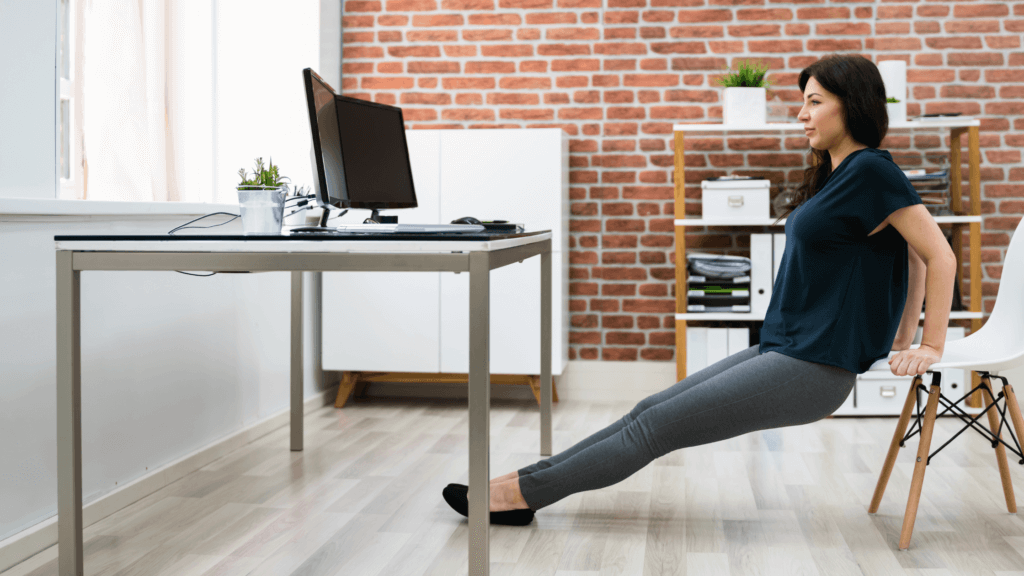It’s common to experience an energy crash after lunch, but that doesn’t mean you just have to accept endless yawns and brain fog. Low energy and fatigue not only interfere with your productivity on the job—they can also be a major safety concern, increasing the risk of accidents. Afternoon fatigue can be caused by heavy meals and your natural circadian rhythms, but you can help even out your energy levels by adding movement and healthy fuel to stay alert and focused.
Quick look
- Large meals, natural circadian rhythms, and cortisol dysregulation can cause afternoon energy slumps.
- Limiting caffeine and ensuring proper hydration can help you maintain consistent energy levels throughout the day.
- If you work a desk job, incorporating desk exercises or a quick walk at lunch can help boost energy levels.
- Healthy, nutrient-dense meals are a key component of energy production; avoid heavy, high-calorie, high-carb meals that will immediately spike blood sugar.
Afternoon grogginess: Why it happens
If you’ve ever struggled to stay awake as the clock ticks closer to 3:00 pm, you have experienced the uniquely energy-sapping phenomenon of the mid-day slump. These energetic black holes can strike while you’re at your desk or working on the job site, leaving you tired, lethargic, unfocused, and unmotivated.
Several factors can cause these slumps, and by understanding each one, you can tackle the issue head-on, keeping you alert and motivated right to the end of the day.
1. Heavy meals
Afternoon energy crashes can sometimes be caused by large lunchtime meals or foods heavy in sugars or refined carbohydrates. When you eat these meals—like a big bowl of pasta or a few greasy burgers—your body will experience a sharp spike in blood sugar as it processes these easily digested fuel sources, followed by an equally sharp sugar crash.
2. Circadian rhythm
Your natural circadian rhythm can also contribute to low afternoon energy levels. Circadian rhythms are like your body’s internal clock, releasing cortisol to help you wake up and melatonin to help you fall asleep. Your circadian rhythm naturally creates a dip in energy after lunch, and many cultures have included a midday nap to accommodate this natural phenomenon. In North America, unfortunately, taking a midday siesta’s generally frowned upon, no matter how tired you are.
3. Dysregulated cortisol
Cortisol dysregulation can also play a role in afternoon grogginess. Being chronically stressed puts pressure on the adrenal glands to constantly pump our cortisol. When you’re in a constant high-cortisol state, eventually, your adrenals can’t keep up, and output becomes a bit wonky. Instead of rising in the morning and falling in the evening, they can fluctuate throughout the day, causing fatigue if they dip in the afternoon. Similarly, if you have adrenal fatigue, your cortisol levels never quite reach the level they’re supposed to, leading to constant grogginess or fatigue.
4 ways to tackle a midday slump
Although some processes contributing to a midday slump are natural, that doesn’t mean you can’t take steps to prevent them. Staying awake and alert is crucial, whether working at heights or drafting a new floor plan.
1. Avoid caffeine

This may seem counterintuitive, but caffeine can worsen your afternoon energy levels. Many of us start the day with caffeine in the form of energy drinks or coffee. This means that the morning jolt has worn off by the time the afternoon rolls around, and you’re left feeling more tired than ever. This caffeine crash is similar to the rollercoaster of highs and lows you experience with blood sugar. To avoid this, try starting your day with lower quantities of caffeine (a small coffee instead of an extra-large, for example) or avoid caffeine altogether.
2. Hydrate

It’s easy to become dehydrated, especially when working hard in hot environments. Dehydration can make you feel thirsty, but it can also make you feel hungry and tired. Bring a reusable water bottle to work with you, and ensure you drink plenty of water. If you’re working outdoors in hot weather, you may also want to consider adding electrolytes to your water to replace the minerals you’re losing through sweat. Staying hydrated can go a long way towards preventing afternoon fatigue, so replace your energy drink with plenty of water and see how it feels!
3. Movement

It’s no coincidence that the mid-afternoon slump often finds you slumped over your desk. After several hours of inactivity, it’s easy for your body to start powering down and shifting into rest mode. It may seem counterintuitive, but adding movement into your day can help you feel more alert and awake. Try taking a brisk walk outside, stretching, doing jumping jacks, or even a few push-ups to help you regain your sense of clarity and focus.
4. Reach for healthy fuel

Instead of a lunch filled with heavy fats and simple carbohydrates, choose healthy fuel. Meals should include fresh fruits and vegetables, lean meats, and whole grains to provide your body with sustained energy. Smaller portions will help you feel satiated without feeling overly full and needing to nap. Looking at your midday meal as a fuel source can help you make healthier choices. Choosing a breakfast that doesn’t spike your blood sugar can also help elimiate the mid-day energy crash.
Bottom line
It’s crucial to stay awake and alert in every industry, especially engineering, architecture, and construction, where fatigue-induced mistakes can add up to costly errors or deadly accidents. Help your body avoid the midday slump by reducing caffeine, incorporating movement into your day, staying hydrated, and consuming healthy, nutrient-dense meals.
Learn more about how to stay happy and healthy under the hard hat by subscribing to our weekly newsletter!


